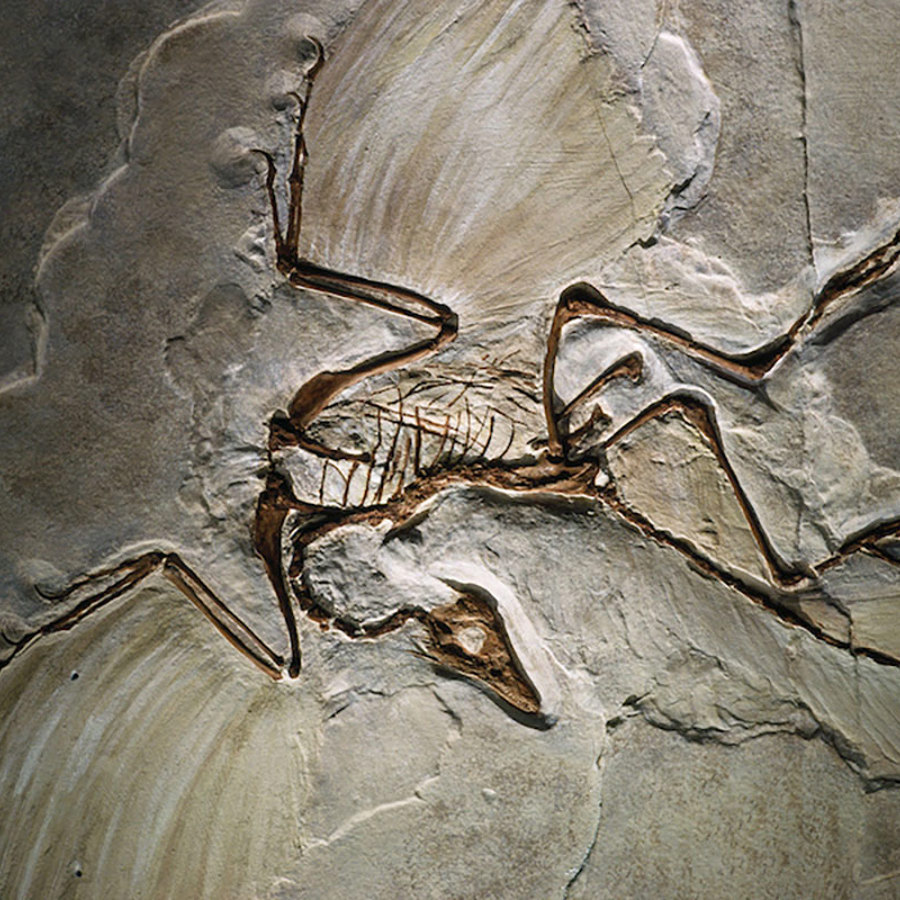
Is it possible to reconstruct dinosaurs from the DNA samples in amber and bird DNA?
July 29, 2010

- Related Topics:
- Quirky questions,
- Futuristic science,
- Ancient DNA
An elementary school student from California asks:
Editor’s note (2/25/2021):
Since this article was published, a lot of progress and breakthroughs have been made in the field of ancient DNA. However, finding DNA from dinosaurs remains part of science fiction. The oldest DNA recovered to date is 1.2 million years old. While this may not quite be the limit to how long DNA can survive, there is now wide consensus in the field that dinosaurs lived too long ago for us to recover any of their DNA. However, it could still be possible to create a more “dinosaur-like” bird, as described towards the end of this article.
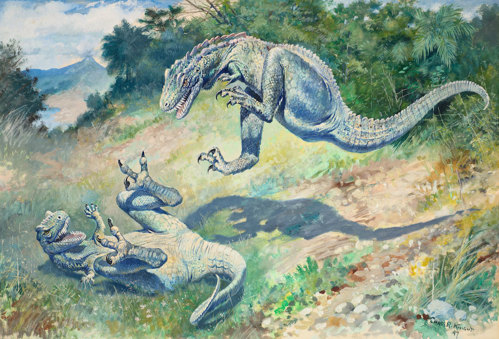
I love this question! In fact, it’s what first got me into genetics when I was in middle school back in the ’90s. Back then I found out the answer was no, we can’t clone dinosaurs. (But I also found out there were a lot of other cool questions to be answered by genetics!)
Unfortunately, dinosaur cloning still seems unlikely today. We have made some progress since Jurassic Park first came out, but live dinosaurs are a long way off.
Since Jurassic Park, scientists have figured out all of the DNA of some long-dead animals like mammoths and Neanderthals. Some others have managed to make DNA from scratch that's good enough to run live bacteria.
These things were incredibly hard to do and they're nothing compared to making a dinosaur. Our technology just isn’t good enough right now.
But it's not all bad news. Read on, and I’ll go into some of the hurdles that stand in the way of cloning dinosaurs. And more importantly, what we might do to get over those hurdles. Some of the options include making a dinosaur with thousands of chromosomes or turning a chicken into a Compsognathus. And those are the easier solutions!
Filling in the gaps
Scientists have been looking for dinosaur DNA for quite a while now. For instance, prehistoric insects can often be found in fossilized tree sap or amber. If a bug sucked blood from a dinosaur, scientists could maybe pull dinosaur DNA out from the insect’s gut.
This is because DNA by itself is very stable, especially in dry, airless conditions like amber. But we can't take the DNA and use it directly to make a dinosaur. For one thing, DNA has to be in long stretches to work and old DNA is usually all broken apart.
Luckily, scientists are pretty good at reading DNA. They might even be able to read fragments of dinosaur DNA and see where they overlap to get a better picture of what longer pieces might look like. In fact, that’s how a lot of DNA gets read today (and how they read mammoth and Neanderthal DNA).
Since dinosaur DNA is really terribly old, though, there would probably be some big gaps in that sequence. In other words, we may never figure out all of a dinosaur’s DNA.
But that isn’t too big a deal either. Scientists can guess at the missing DNA by looking at DNA from related species.
For instance, in Jurassic Park the scientists used frog DNA to fill in those gaps. Even 15 years ago that was a bit of a stretch – after all, dinosaurs were reptiles and frogs are amphibians! Frog DNA would probably be too different from dinosaur DNA to be helpful.
But you mentioned the answer to this problem in your question, which is one big thing that has changed since Jurassic Park came out. Scientists have been studying how birds evolved and found that they most likely came from dinosaur ancestors. So from what we know now, bird DNA might be a better choice than frog or lizard.
One thing they’d have to worry about is DNA rearrangement. During evolution and development, DNA can get shuffled around. The result is that modern bird DNA might contain a lot of the same information as dinosaur DNA, but it might be in a different order. And this shuffling might make it harder to compare.
However, even if scientists could fill any gaps with bird DNA, that’s not the end of the story. There are still lots of issues to solve before we could get a live dinosaur.
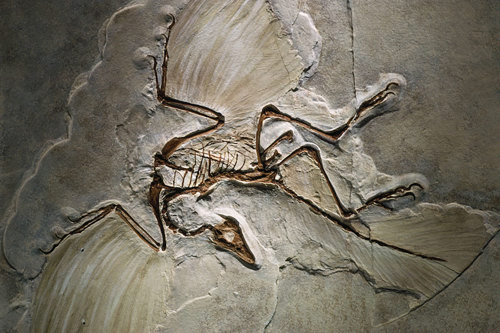
Making chromosomes
One problem is that cells don’t know what to do with DNA unless it’s found in chromosomes. And scientists aren't great at making those yet.
So what’s a chromosome? Chromosomes are long, organized pieces of DNA, wound up tightly. Coiled up, a chromosome is less than 1/100,000th of a centimeter long. Stretched out, that same DNA can be longer than 5 cm and 1/50th the width of a human hair.
Like I said, when DNA isn’t in chromosomes, it won’t be able to do its job. Those fragments from the amber won’t help build a real live dinosaur!
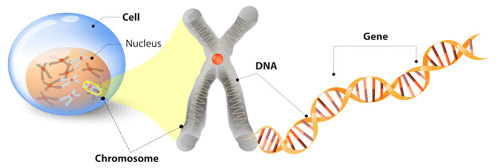
Scientists would first need to use the information from the DNA fragments to make a long piece of DNA. Then they would need to package it up properly, which can only be done by a live cell. Believe it or not, the most likely candidate for the job is the yeast used to make beer! The DNA won’t work in the yeast cell, but it will get bundled up into chromosomes.
Once the DNA is all packaged up, it can be taken out of the yeast and put into a specific host cell. This way it has a much better chance of actually working.
This all sounds pretty far-fetched, but just recently, scientists were able to make an entire working genome for a microbe. They stuck together long pieces of DNA, put it into yeast for packaging, then transferred it into a bacterium. The new DNA “took over” and ran the cell.
There are a couple problems with trying to use the same type of method to make a dinosaur. First of all, a microbe needs a lot less DNA than a dinosaur would. So it would take a lot of these human-made mini-chromosomes to hold the whole dinosaur genome. Maybe a thousand or more of them!
Even that’s not impossible. Although people have 23 pairs of chromosomes, lots of things have more. There’s even a fern that has around 600 pairs! It’s definitely possible to use lots of small chromosomes for our cloned dinosaur.
But here comes another big problem.
Homeless DNA
The problem here is that the DNA has to be put into a cell to work and we don’t have a dinosaur cell. We also don’t know how to make a new one. So we’d need to use a cell from another animal – a bird or lizard probably.
But when you put dinosaur DNA in a non-dinosaur cell, you may have even more problems. The dinosaur DNA may not be able to talk to the machinery in the rest of the cell, since they’re from different animals. And if that communication fails, the cell will just die. So no dinosaur.
Of course, we could get lucky and it might work. But most likely, without a dinosaur cell to put our dinosaur DNA into, we’ve hit a dead end. Or have we?
Retrofitting Bird DNA
Okay, so let’s take a step back and see if we have any other options. What if we use bird DNA as our starting material instead of just using it to fill in gaps?
When scientists look at DNA from lots of related living species, they can start to figure out what the DNA from their shared ancestor might have looked like. So if they look at enough modern birds and lizards and whatnot, they may be able to get an idea of what a dinosaur’s DNA looked like.
Maybe scientists could combine that knowledge with what they've learned from the dinosaur DNA to change a bird into a dinosaur. In other words, they could take bird DNA and “revert” it to the original dinosaur version.
Using “fixed” bird DNA gets around the problem I talked about earlier with communication in the cell. Since most of the DNA is still the bird kind, the bird cell should be able to do its job, growing and dividing into a baby ... thing.
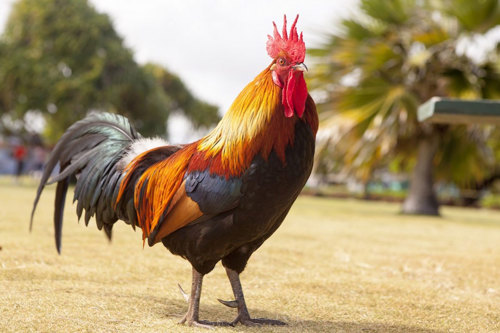
One Step at a Time
Of course, “fixing” bird DNA would be incredibly hard. First, scientists would have to figure out what genes to change, which is not a small task! Then, they’d need to take out the DNA and change the genes, not something we're particularly good at just yet.
Even if they had a good way to change genes, they’d probably only want to do a few genes at a time. Too big a change might mean that when they put the DNA in a bird cell, it could be too “foreign.” Not to mention what would happen if they messed up a gene enough that the animal wouldn’t survive!
The number of genes that would need to be changed is probably in the hundreds, maybe thousands. The bird’s beak, wings, feathers and hollow bones are all wrong for most dinosaurs. They’d need to be changed to teeth, arms, scales, and thick, strong bones. Each of those things would require changes in lots of genes. And that’s just the differences you can see!
For each small change, scientists would have to take out the DNA, put in new versions of a gene, put it into a cell and hope it grows. If it does, they’d have to wait until it was grown into an adult animal, then take out its DNA and change a few more genes. So it would take a really long time to make a dinosaur this way.
In fact, this is sort of how evolution works – some dinosaurs evolved into birds over the course of millions of years as each of these genes was slowly changed. In evolution these changes happen pretty much randomly. Then, the useful changes are passed onto the next generation.
Since the scientists would be directing the changes this time, it probably wouldn’t take millions of years. But it would probably take several generations of scientists. And that’s all if they had technology fancier than they currently do!
So we can’t get excited (or worried) about a real Jurassic Park any time soon. And it looks like we may never be able to clone dinosaurs. It doesn’t look any more likely now than it did in the 90’s. But I'll get back to you in another 15 years!
Read More:
- TED talk: Building a dinosaur from a chicken
- Scientific American: How close are we to being able to reconstruct dino DNA? (1999)
- Livescience: ‘Jurassic Park’ May Be Impossible, But Dino DNA Lasts Longer Than Thought

 Skip Navigation
Skip Navigation
